Foundations of Informatics: Evolution of Health Informatics Report
VerifiedAdded on 2022/09/07
|6
|1178
|45
Report
AI Summary
This report provides a comprehensive overview of the evolution of health informatics as a discipline, tracing its development from the 1950s with the advent of computer-generated healthcare data to its current state. It discusses the emergence of key organizations like AAMSI, SCAMC, AHIMA, AMIA, HIMSS, and ANIA, and HL7, highlighting their roles in standardizing information and improving healthcare systems. The report also examines the impact of health informatics on healthcare delivery, emphasizing the benefits of data analysis, electronic health records, and the reduction of errors and costs. It further explores the future impact of health informatics, predicting significant savings, improved communication, and enhanced coordination within healthcare systems, leading to better patient care and more efficient healthcare delivery in the next 3-5 years. The report concludes by emphasizing the importance of data-driven decision-making and the role of informatics professionals in improving patient health and healthcare outcomes.
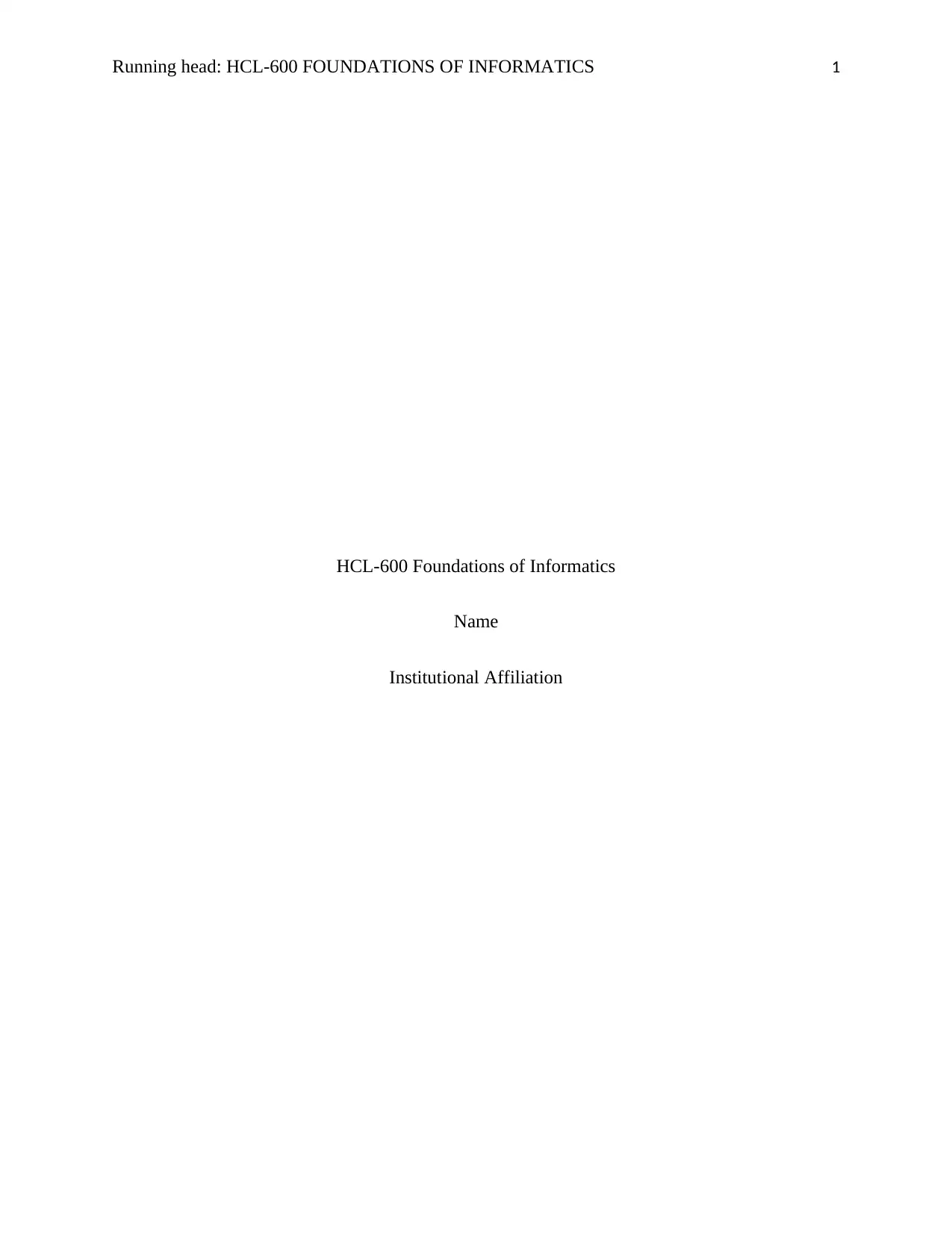
Running head: HCL-600 FOUNDATIONS OF INFORMATICS 1
HCL-600 Foundations of Informatics
Name
Institutional Affiliation
HCL-600 Foundations of Informatics
Name
Institutional Affiliation
Paraphrase This Document
Need a fresh take? Get an instant paraphrase of this document with our AI Paraphraser
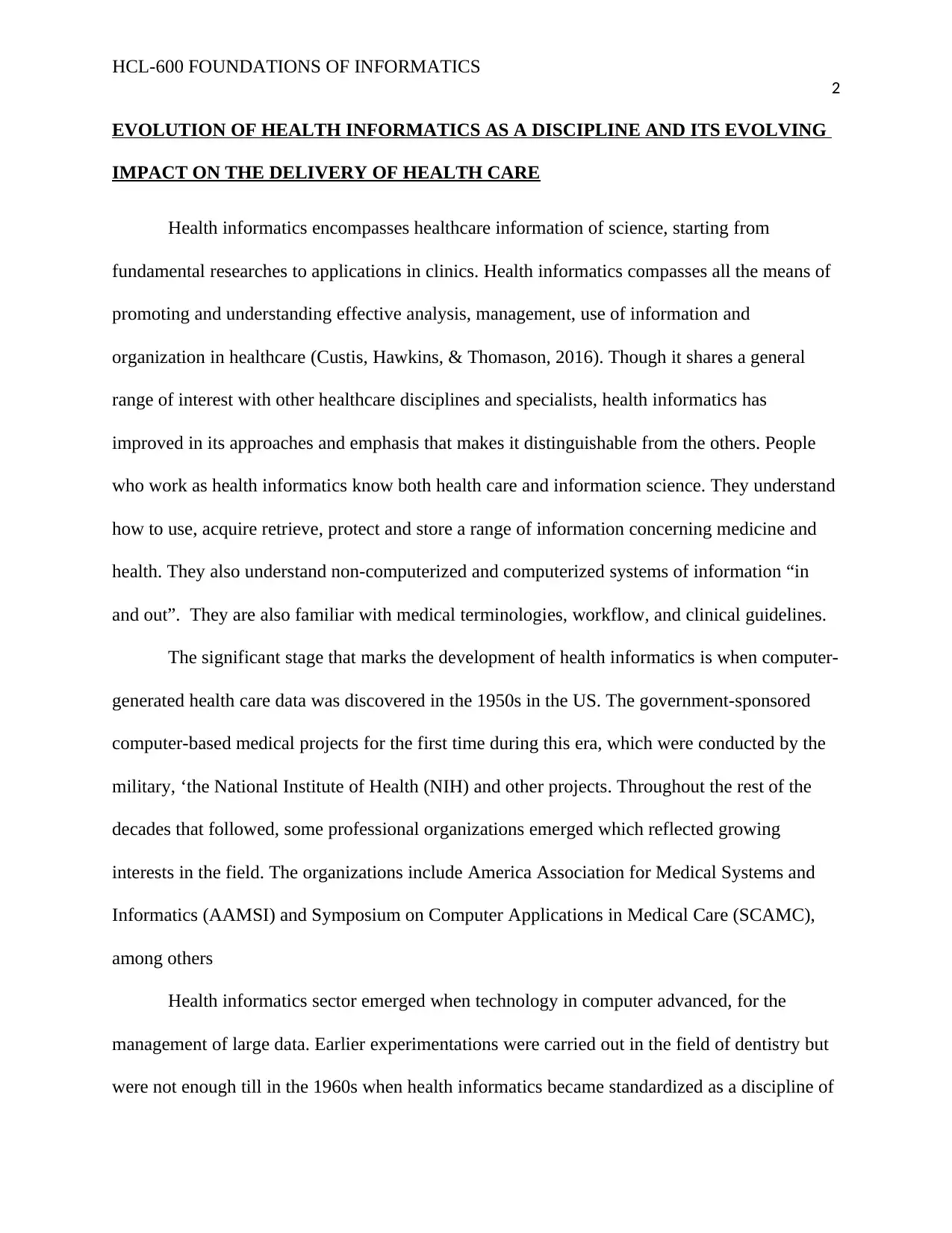
HCL-600 FOUNDATIONS OF INFORMATICS
2
EVOLUTION OF HEALTH INFORMATICS AS A DISCIPLINE AND ITS EVOLVING
IMPACT ON THE DELIVERY OF HEALTH CARE
Health informatics encompasses healthcare information of science, starting from
fundamental researches to applications in clinics. Health informatics compasses all the means of
promoting and understanding effective analysis, management, use of information and
organization in healthcare (Custis, Hawkins, & Thomason, 2016). Though it shares a general
range of interest with other healthcare disciplines and specialists, health informatics has
improved in its approaches and emphasis that makes it distinguishable from the others. People
who work as health informatics know both health care and information science. They understand
how to use, acquire retrieve, protect and store a range of information concerning medicine and
health. They also understand non-computerized and computerized systems of information “in
and out”. They are also familiar with medical terminologies, workflow, and clinical guidelines.
The significant stage that marks the development of health informatics is when computer-
generated health care data was discovered in the 1950s in the US. The government-sponsored
computer-based medical projects for the first time during this era, which were conducted by the
military, ‘the National Institute of Health (NIH) and other projects. Throughout the rest of the
decades that followed, some professional organizations emerged which reflected growing
interests in the field. The organizations include America Association for Medical Systems and
Informatics (AAMSI) and Symposium on Computer Applications in Medical Care (SCAMC),
among others
Health informatics sector emerged when technology in computer advanced, for the
management of large data. Earlier experimentations were carried out in the field of dentistry but
were not enough till in the 1960s when health informatics became standardized as a discipline of
2
EVOLUTION OF HEALTH INFORMATICS AS A DISCIPLINE AND ITS EVOLVING
IMPACT ON THE DELIVERY OF HEALTH CARE
Health informatics encompasses healthcare information of science, starting from
fundamental researches to applications in clinics. Health informatics compasses all the means of
promoting and understanding effective analysis, management, use of information and
organization in healthcare (Custis, Hawkins, & Thomason, 2016). Though it shares a general
range of interest with other healthcare disciplines and specialists, health informatics has
improved in its approaches and emphasis that makes it distinguishable from the others. People
who work as health informatics know both health care and information science. They understand
how to use, acquire retrieve, protect and store a range of information concerning medicine and
health. They also understand non-computerized and computerized systems of information “in
and out”. They are also familiar with medical terminologies, workflow, and clinical guidelines.
The significant stage that marks the development of health informatics is when computer-
generated health care data was discovered in the 1950s in the US. The government-sponsored
computer-based medical projects for the first time during this era, which were conducted by the
military, ‘the National Institute of Health (NIH) and other projects. Throughout the rest of the
decades that followed, some professional organizations emerged which reflected growing
interests in the field. The organizations include America Association for Medical Systems and
Informatics (AAMSI) and Symposium on Computer Applications in Medical Care (SCAMC),
among others
Health informatics sector emerged when technology in computer advanced, for the
management of large data. Earlier experimentations were carried out in the field of dentistry but
were not enough till in the 1960s when health informatics became standardized as a discipline of
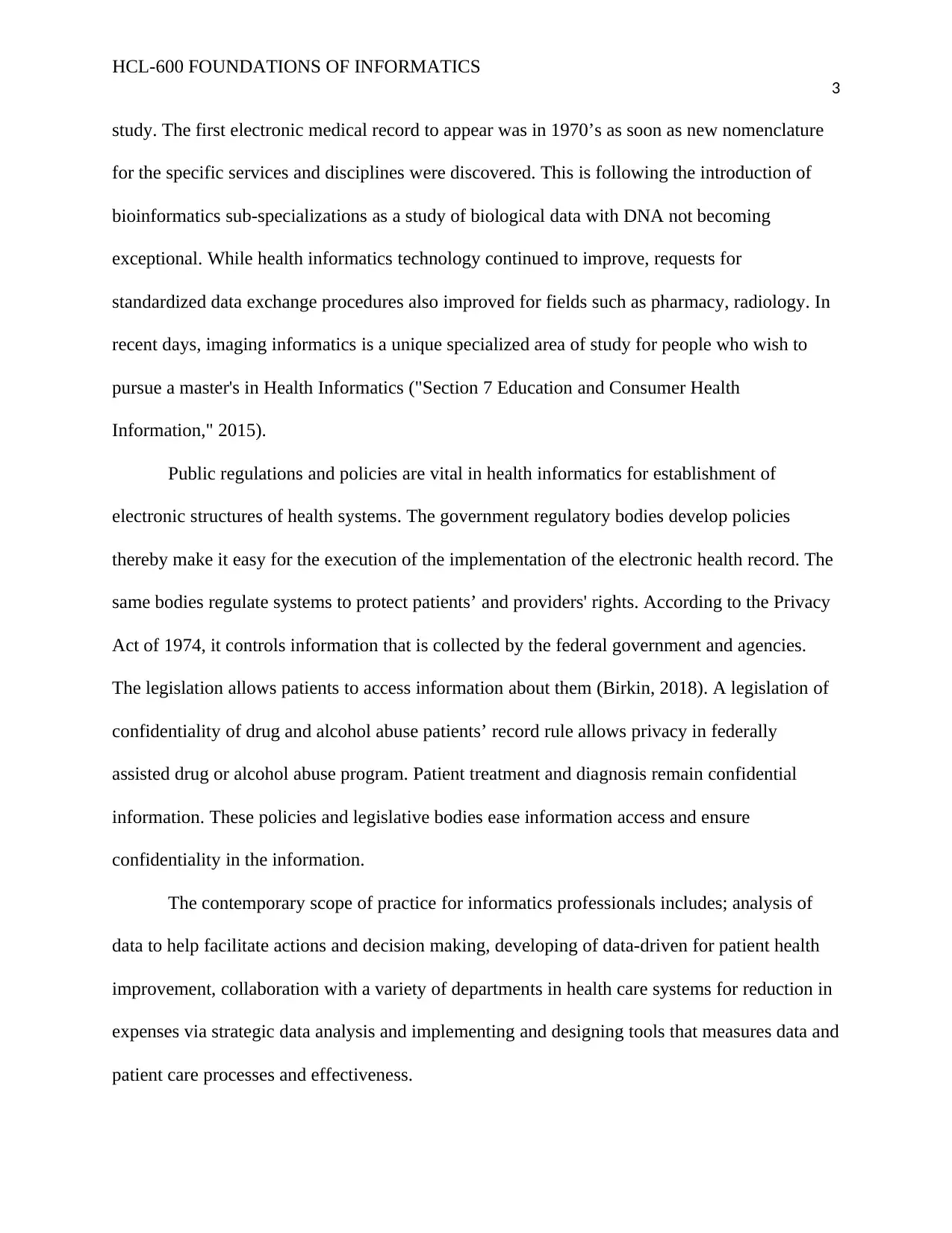
HCL-600 FOUNDATIONS OF INFORMATICS
3
study. The first electronic medical record to appear was in 1970’s as soon as new nomenclature
for the specific services and disciplines were discovered. This is following the introduction of
bioinformatics sub-specializations as a study of biological data with DNA not becoming
exceptional. While health informatics technology continued to improve, requests for
standardized data exchange procedures also improved for fields such as pharmacy, radiology. In
recent days, imaging informatics is a unique specialized area of study for people who wish to
pursue a master's in Health Informatics ("Section 7 Education and Consumer Health
Information," 2015).
Public regulations and policies are vital in health informatics for establishment of
electronic structures of health systems. The government regulatory bodies develop policies
thereby make it easy for the execution of the implementation of the electronic health record. The
same bodies regulate systems to protect patients’ and providers' rights. According to the Privacy
Act of 1974, it controls information that is collected by the federal government and agencies.
The legislation allows patients to access information about them (Birkin, 2018). A legislation of
confidentiality of drug and alcohol abuse patients’ record rule allows privacy in federally
assisted drug or alcohol abuse program. Patient treatment and diagnosis remain confidential
information. These policies and legislative bodies ease information access and ensure
confidentiality in the information.
The contemporary scope of practice for informatics professionals includes; analysis of
data to help facilitate actions and decision making, developing of data-driven for patient health
improvement, collaboration with a variety of departments in health care systems for reduction in
expenses via strategic data analysis and implementing and designing tools that measures data and
patient care processes and effectiveness.
3
study. The first electronic medical record to appear was in 1970’s as soon as new nomenclature
for the specific services and disciplines were discovered. This is following the introduction of
bioinformatics sub-specializations as a study of biological data with DNA not becoming
exceptional. While health informatics technology continued to improve, requests for
standardized data exchange procedures also improved for fields such as pharmacy, radiology. In
recent days, imaging informatics is a unique specialized area of study for people who wish to
pursue a master's in Health Informatics ("Section 7 Education and Consumer Health
Information," 2015).
Public regulations and policies are vital in health informatics for establishment of
electronic structures of health systems. The government regulatory bodies develop policies
thereby make it easy for the execution of the implementation of the electronic health record. The
same bodies regulate systems to protect patients’ and providers' rights. According to the Privacy
Act of 1974, it controls information that is collected by the federal government and agencies.
The legislation allows patients to access information about them (Birkin, 2018). A legislation of
confidentiality of drug and alcohol abuse patients’ record rule allows privacy in federally
assisted drug or alcohol abuse program. Patient treatment and diagnosis remain confidential
information. These policies and legislative bodies ease information access and ensure
confidentiality in the information.
The contemporary scope of practice for informatics professionals includes; analysis of
data to help facilitate actions and decision making, developing of data-driven for patient health
improvement, collaboration with a variety of departments in health care systems for reduction in
expenses via strategic data analysis and implementing and designing tools that measures data and
patient care processes and effectiveness.
⊘ This is a preview!⊘
Do you want full access?
Subscribe today to unlock all pages.

Trusted by 1+ million students worldwide
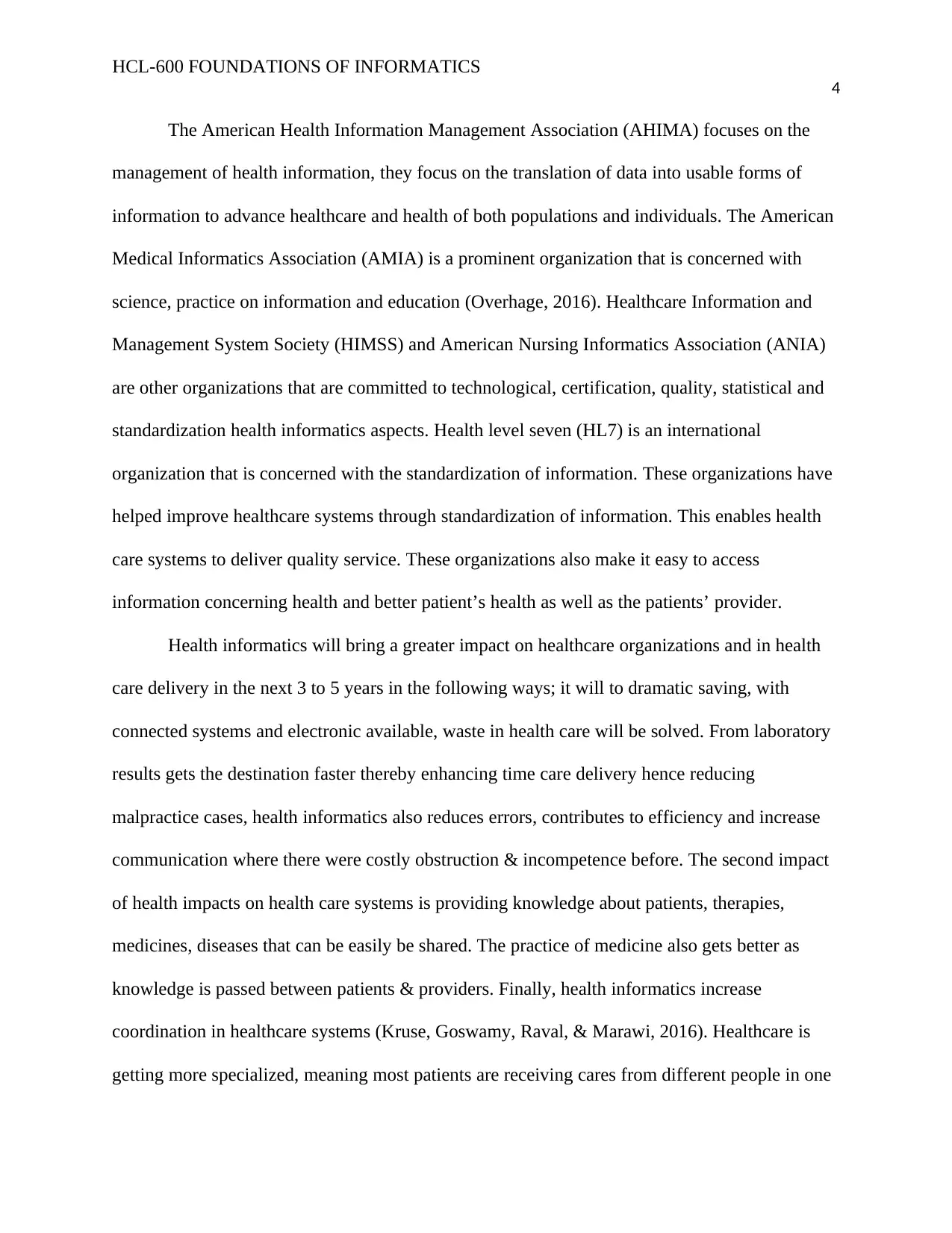
HCL-600 FOUNDATIONS OF INFORMATICS
4
The American Health Information Management Association (AHIMA) focuses on the
management of health information, they focus on the translation of data into usable forms of
information to advance healthcare and health of both populations and individuals. The American
Medical Informatics Association (AMIA) is a prominent organization that is concerned with
science, practice on information and education (Overhage, 2016). Healthcare Information and
Management System Society (HIMSS) and American Nursing Informatics Association (ANIA)
are other organizations that are committed to technological, certification, quality, statistical and
standardization health informatics aspects. Health level seven (HL7) is an international
organization that is concerned with the standardization of information. These organizations have
helped improve healthcare systems through standardization of information. This enables health
care systems to deliver quality service. These organizations also make it easy to access
information concerning health and better patient’s health as well as the patients’ provider.
Health informatics will bring a greater impact on healthcare organizations and in health
care delivery in the next 3 to 5 years in the following ways; it will to dramatic saving, with
connected systems and electronic available, waste in health care will be solved. From laboratory
results gets the destination faster thereby enhancing time care delivery hence reducing
malpractice cases, health informatics also reduces errors, contributes to efficiency and increase
communication where there were costly obstruction & incompetence before. The second impact
of health impacts on health care systems is providing knowledge about patients, therapies,
medicines, diseases that can be easily be shared. The practice of medicine also gets better as
knowledge is passed between patients & providers. Finally, health informatics increase
coordination in healthcare systems (Kruse, Goswamy, Raval, & Marawi, 2016). Healthcare is
getting more specialized, meaning most patients are receiving cares from different people in one
4
The American Health Information Management Association (AHIMA) focuses on the
management of health information, they focus on the translation of data into usable forms of
information to advance healthcare and health of both populations and individuals. The American
Medical Informatics Association (AMIA) is a prominent organization that is concerned with
science, practice on information and education (Overhage, 2016). Healthcare Information and
Management System Society (HIMSS) and American Nursing Informatics Association (ANIA)
are other organizations that are committed to technological, certification, quality, statistical and
standardization health informatics aspects. Health level seven (HL7) is an international
organization that is concerned with the standardization of information. These organizations have
helped improve healthcare systems through standardization of information. This enables health
care systems to deliver quality service. These organizations also make it easy to access
information concerning health and better patient’s health as well as the patients’ provider.
Health informatics will bring a greater impact on healthcare organizations and in health
care delivery in the next 3 to 5 years in the following ways; it will to dramatic saving, with
connected systems and electronic available, waste in health care will be solved. From laboratory
results gets the destination faster thereby enhancing time care delivery hence reducing
malpractice cases, health informatics also reduces errors, contributes to efficiency and increase
communication where there were costly obstruction & incompetence before. The second impact
of health impacts on health care systems is providing knowledge about patients, therapies,
medicines, diseases that can be easily be shared. The practice of medicine also gets better as
knowledge is passed between patients & providers. Finally, health informatics increase
coordination in healthcare systems (Kruse, Goswamy, Raval, & Marawi, 2016). Healthcare is
getting more specialized, meaning most patients are receiving cares from different people in one
Paraphrase This Document
Need a fresh take? Get an instant paraphrase of this document with our AI Paraphraser
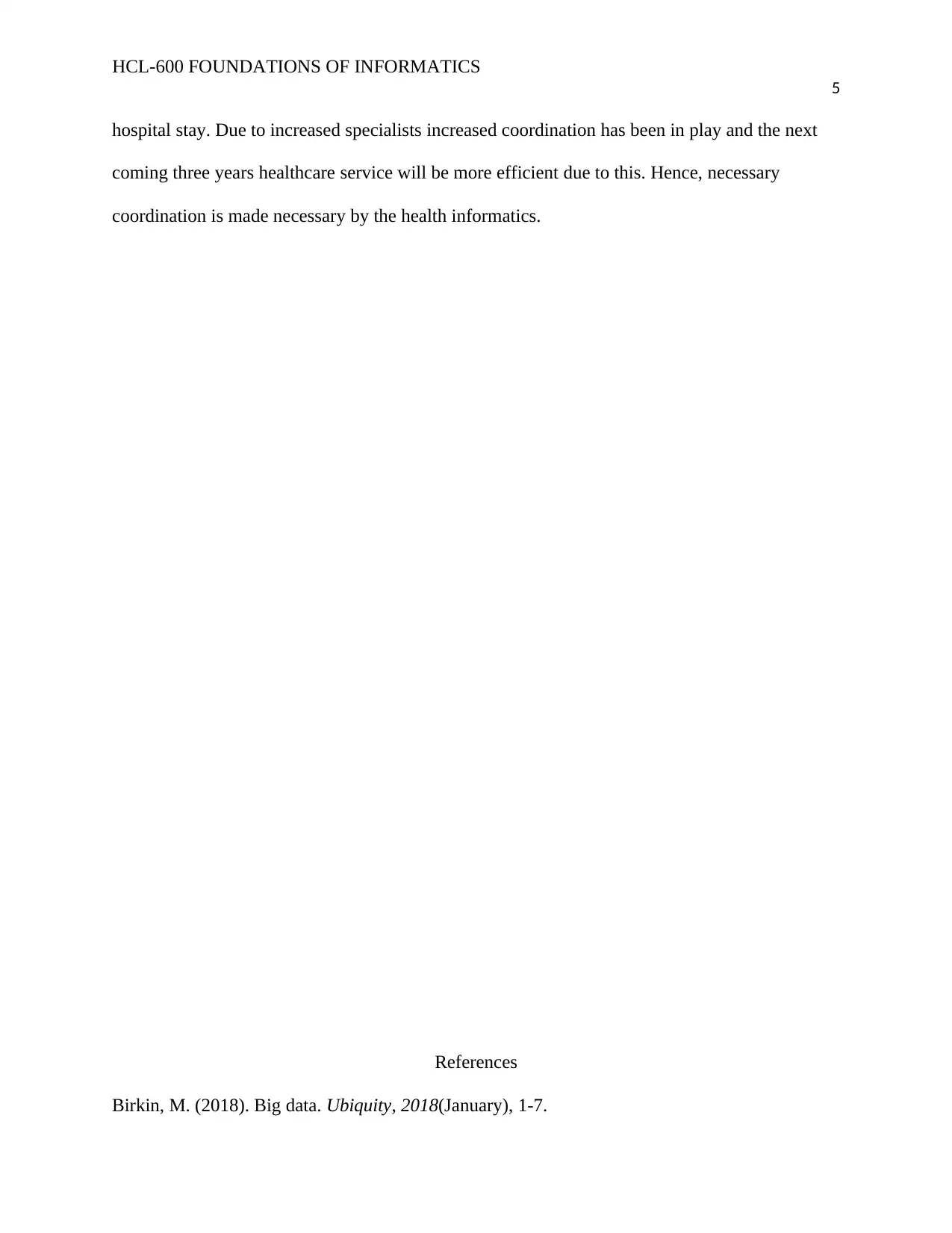
HCL-600 FOUNDATIONS OF INFORMATICS
5
hospital stay. Due to increased specialists increased coordination has been in play and the next
coming three years healthcare service will be more efficient due to this. Hence, necessary
coordination is made necessary by the health informatics.
References
Birkin, M. (2018). Big data. Ubiquity, 2018(January), 1-7.
5
hospital stay. Due to increased specialists increased coordination has been in play and the next
coming three years healthcare service will be more efficient due to this. Hence, necessary
coordination is made necessary by the health informatics.
References
Birkin, M. (2018). Big data. Ubiquity, 2018(January), 1-7.
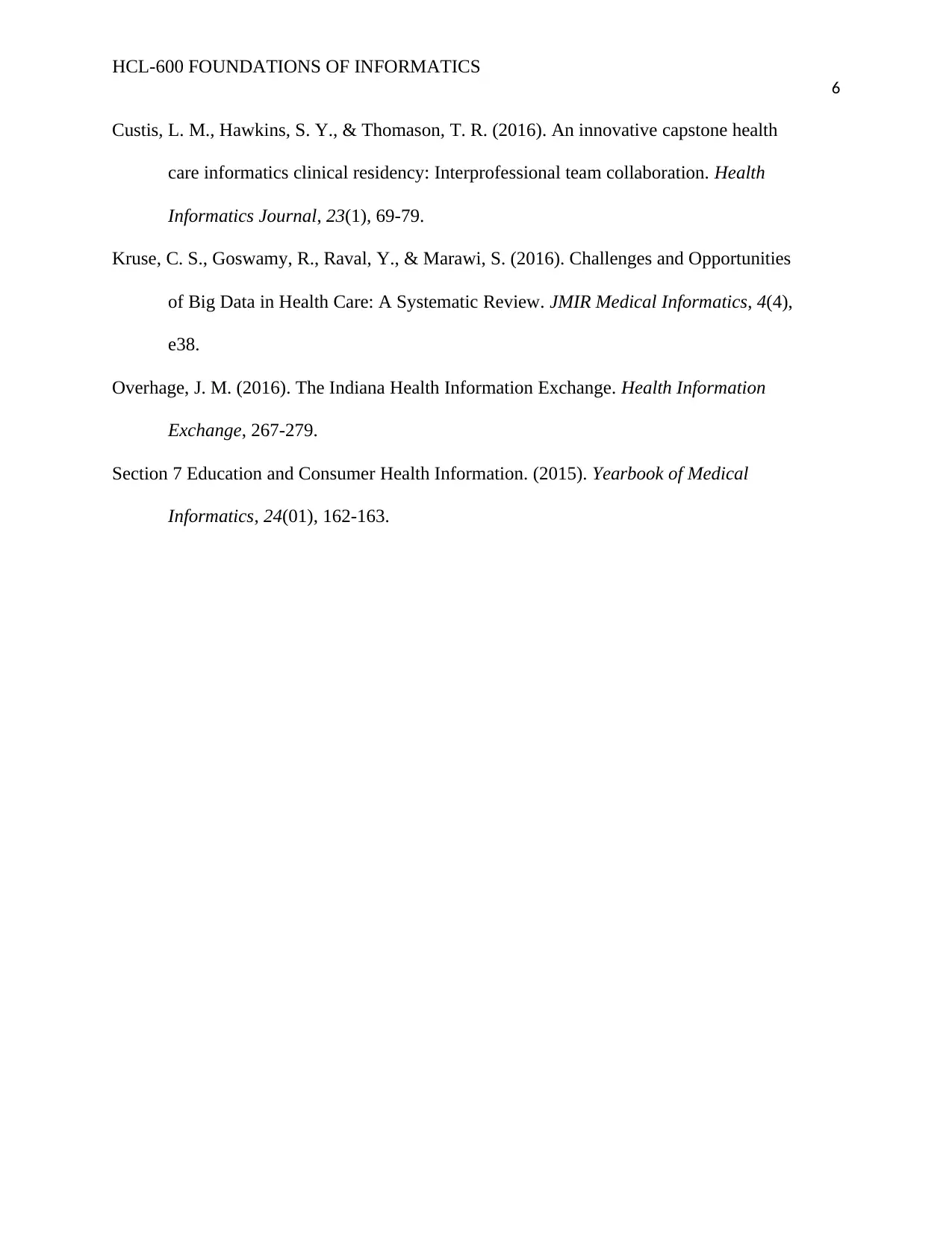
HCL-600 FOUNDATIONS OF INFORMATICS
6
Custis, L. M., Hawkins, S. Y., & Thomason, T. R. (2016). An innovative capstone health
care informatics clinical residency: Interprofessional team collaboration. Health
Informatics Journal, 23(1), 69-79.
Kruse, C. S., Goswamy, R., Raval, Y., & Marawi, S. (2016). Challenges and Opportunities
of Big Data in Health Care: A Systematic Review. JMIR Medical Informatics, 4(4),
e38.
Overhage, J. M. (2016). The Indiana Health Information Exchange. Health Information
Exchange, 267-279.
Section 7 Education and Consumer Health Information. (2015). Yearbook of Medical
Informatics, 24(01), 162-163.
6
Custis, L. M., Hawkins, S. Y., & Thomason, T. R. (2016). An innovative capstone health
care informatics clinical residency: Interprofessional team collaboration. Health
Informatics Journal, 23(1), 69-79.
Kruse, C. S., Goswamy, R., Raval, Y., & Marawi, S. (2016). Challenges and Opportunities
of Big Data in Health Care: A Systematic Review. JMIR Medical Informatics, 4(4),
e38.
Overhage, J. M. (2016). The Indiana Health Information Exchange. Health Information
Exchange, 267-279.
Section 7 Education and Consumer Health Information. (2015). Yearbook of Medical
Informatics, 24(01), 162-163.
⊘ This is a preview!⊘
Do you want full access?
Subscribe today to unlock all pages.

Trusted by 1+ million students worldwide
1 out of 6
Related Documents
Your All-in-One AI-Powered Toolkit for Academic Success.
+13062052269
info@desklib.com
Available 24*7 on WhatsApp / Email
![[object Object]](/_next/static/media/star-bottom.7253800d.svg)
Unlock your academic potential
Copyright © 2020–2025 A2Z Services. All Rights Reserved. Developed and managed by ZUCOL.





